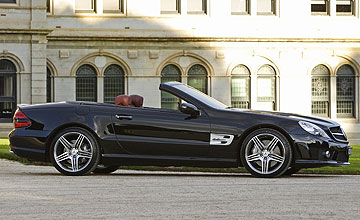BY GEORGIA OCONNELL | 26th Jun 2008

Prices are also up by between $4000 and $8000 across the range which starts at $223,000 for the entry-level SL350 and tops out at $468,000 for the AMG SL65.
All SL models have been revised, but it is the SL350 and AMG SL63 that have been improved the most. In case of the SL350, the V6 has been substantially revised to increase its power output by 16 per cent for an impressive total of 232kW. Torque is up by 10Nm to 360Nm.
The engine is still a 3.5-litre with four valves per cylinder, but Mercedes has introduced a range of changes to make it work harder. These include increasing the compression ratio from 10.7:1 to 11.7:1.
In order to accommodate this change, Mercedes has introduced new lighter pistons, deeper valve pockets, reinforced piston pins and a new intake manifold.
As a result, the engine can rev all the way to 7200rpm. While the top-end performance has been improved, the revised V6 has more meat low down in the rev range and is able to deliver 97 per cent of its maximum torque from just 2000rpm.
The changes allow the SL350 to dash from 0-100km/h in 6.2 seconds, which is 0.4 seconds faster than the previous model. Like all SLs, the top speed is electronically limited at 250km/h.
The SL350 has been upgraded to a seven-speed automatic transmission. It runs a new double-declutching function which operates during downshifts.
sl_stack.jpg Mercedes claims this function allows for smoother changes by equalising the rotational speeds of the crankshaft and transmission. It adds that it also sounds better.
The new seven-speed automatic also helps lower the car’s fuel consumption, which has been improved by 0.8L/100km for an average 9.9L/100km when tested to the ADR 81/01 standard.
The SL has finally been upgraded with the 6.2-litre AMG V8 that was introduced three years ago, replacing the 5.4-litre supercharged V8.
The new engine, which Mercedes refers to a 6.3-litre unit even though actual displacement is 6208cc, produces a whopping 386kW and 630Nm of torque.
That allows the SL63 AMG to blast from 0-100km/h in just 4.6 seconds. Fuel consumption comes in at 13.9L/100km.
The SL63 uses a similar seven-speed automatic to the SL350 and SL500, but the transmission uses a wet start-up clutch which replaces the torque converter to allow for quicker shifts and a more effective launch system.
Mercedes says the new system weighs just 80kg thanks to dispensing with the torque converter and using a lightweight magnesium transmission housing.
The 5.5-litre V8 of the SL500, the twin turbo 5.5-litre V8 of the SL600 and the twin-turbo V12 of the SL65 AMG remain unchanged.the SL600 generates 380kW and 830Nm, while the monster SL65 pumps out 450kW and 1000Nm of torque.
Both the SL600 and SL65 make do with a five-speed automatic as they both produce too much torque for the seven-speed transmission to handle.
Mercedes has introduced a new ‘dynamic’ ratio steering rack for all variants, which will be available with a direct-steer system for all non-AMG models.
Developed by an Australian company, direct steer uses servo assistance to help provide more agile steering and a sharper, more direct, feel.
The system will be available in Australia late this year. Other changes include revisions to the Active Body Control adaptive suspension, which is now standard on all SLs except for the SL350.
The SL350 and SL500 now come with 18-inch light-alloy wheels, while a cornering function has been added as standard to the bi-Xenon headlights. The foglights have also been improved.
Another feature that has been included for all SL models is the Airscarf system which warms the neck of the driver and passenger by pumping warm air through a vent located at the top of the seat and below the headrest to enable top-down driving in cooler conditions.
New technology features include a new Command APS system (with hard-disc satellite navigation) and a Linguatronic voice-operated control system. A Harman Kardon Logic7 surroundsound system with 510 watts and 10 highperformance speakers is standard.
Owners can connect a USB stick or other external audio devices to the sound system via a new media interface.
It also hooks up with the SL’s on-board electronics to allow the iPod’s music tracks to be indicated on the instrument cluster and called up using buttons on the steering wheel. This system also allows the media device to be charged up.
Mercedes has upgraded the exterior styling, moving away from the twin-bulb headlight treatment and opting instead for an L-shaped single-bulb shape. The front of the SL is now dominated by a bigger grille, with an enlarged tri-star badge in the middle.
Mercedes has replaced the front quarter panels and a new bonnet with two raised lines which Mercedes refers to as ‘powerdomes’.
There is a deeper rear bumper for all models, while the SL600 has new tailpipes and new 10-spoke 18-inch alloy wheels. Inside, Mercedes has introduced a new instrument cluster.
Although Mercedes is not about to admit it, the new cluster mimics the Subaru premium instrument cluster which rotate once around their dials and then back to their sitting position when the ignition is switched on.
Mercedes has also introduced a new steering wheel, new seat trim, a new interior colour (beige) and new woodgrain finish.
The price increases for the SL range have nothing to do with proposed Luxury Car Tax changes. Instead, Mercedes says they are due to the increased value of new features.